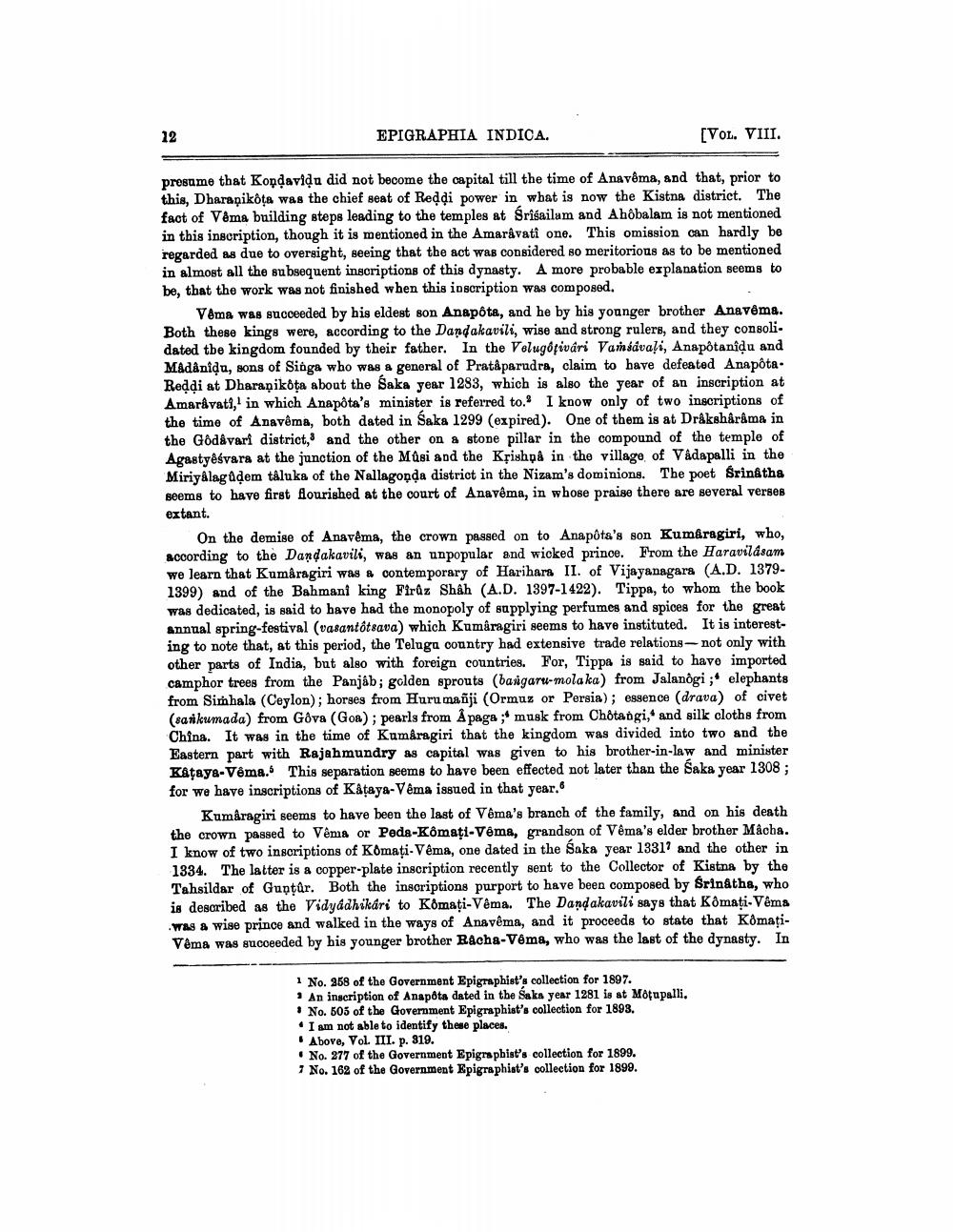________________
EPIGRAPHIA INDICA.
[VOL. VIII.
presume that Kondavidu did not become the capital till the time of Anavêma, and that, prior to this, Dharaộikóta was the chief seat of Reddi power in what is now the Kistna district. The fact of Vêma building steps leading to the temples at Srisailam and Ahôbalam is not mentioned in this inscription, though it is mentioned in the Amaravati one. This omission can hardly be regarded as due to oversight, seeing that the act was considered so meritorious as to be mentioned in almost all the subsequent inscriptions of this dynasty. A more probable explanation seems to be, that the work was not finished when this inscription was composed.
Véma was succeeded by his eldest son Anapota, and he by his younger brother Anavêma. Both these kings were, according to the Dandakavili, wise and strong rulers, and they consoli. dated the kingdom founded by their father. In the Velugôțivari Vankávali, Anapôtanidu and Madanidu, sons of Singa who was a general of Pratâparadra, claim to have defeated AnapôtaReddi at Dharapikota about the Saka year 1283, which is also the year of an inscription at Amaravati, in which Anapôta's minister is referred to. I know only of two inscriptions of the time of Anavêma, both dated in Saka 1299 (expired). One of them is at Dråkshårâma in the Godavari district, and the other on a stone pillar in the compound of the temple of Agastyêśvara at the junction of the Mûsi and the Krishpå in the village of Vadapalli in the MiriyAlagadem tåluka of the Nallagonda district in the Nizam's dominions. The poet Srinatha seems to have first flourished at the court of Anavêma, in whose praise there are several verses extant.
On the demise of Anavema, the crown passed on to Anapôts's son Kumäragiri, who, according to the Dandakavili, was an unpopular and wicked prince. From the Haravildsam we learn that Kumâragiri was & contemporary of Harihara II. of Vijayanagara (A.D. 13791399) and of the Bahmani king Firuz Shah (A.D. 1397-1422). Tippa, to whom the book was dedicated, is said to have had the monopoly of supplying perfumes and spices for the great annual spring-festival (vasantôtsava) which Kumaragiri seems to have instituted. It is interesting to note that, at this period, the Teluga country had extensive trade relations- not only with other parts of India, but also with foreign countries. For, Tippa is said to have imported camphor trees from the Panjab; golden sprouts (bangaru-mola ka) from Jalanogi ;* elephants from Simhala (Ceylon); horses from Huru mañji (Ormuz or Persia); essence (drava) of civet (sanikumada) from Gova (Goa); pearls from Åpaga;' musk from Chôtangi, and silk cloths from China. It was in the time of Kumâragiri that the kingdom was divided into two and the Eastern part with Rajahmundry as capital was given to his brother-in-law and minister KAğaye-Vêma. This separation seems to have been effected not later than the Saka year 1308; for we have inscriptions of Kataya-Véma issued in that year.
Kumâragiri seems to have been the last of Vêma's branch of the family, and on his death the crown passed to Vêma or Peda-Kômaţi-Vēma, grandson of Vema's elder brother Macha. I know of two inscriptions of Kömaţi-Vêma, one dated in the Saka year 13317 and the other in 1334. The latter is a copper-plate inscription recently sent to the Collector of Kistna by the Tahsildar of Guntür. Both the inscriptions purport to have been composed by Srinatha, who is described as the Vidyadhikari to Komati-Vêma. The Dandakavili says that Kômaţi-Véma was a wise prince and walked in the ways of Anavêma, and it proceeds to state that KəmațiVoma was succeeded by his younger brother Rache-Vema, who was the last of the dynasty. In
1 No. 258 of the Government Epigraphist's collection for 1897. : An inscription of Anapôts dated in the Saks year 1281 is st Mötupalli. • No. 505 of the Government Epigraphist's collection for 1893. • I am not able to identify these places. . Above, Vol. III. p. 319. • No. 277 of the Government Epigrapbist's collection for 1899. 7 No. 162 of the Government Epigraphist's collection for 1899.




